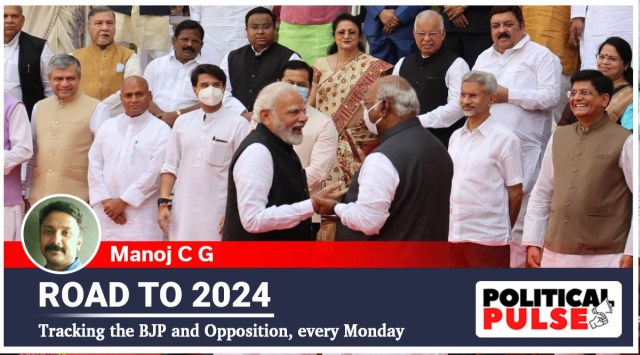Road to 2024 | As Modi makes the poll contest personal, can Congress keep the focus on issues?
PM Modi’s decision to once again turn the upcoming polls into a personality-driven affair, by asking voters to vote for him, could pose a challenge for the Congress.

In the run-up to the Uttarakhand Assembly elections earlier this year, former CM Harish Rawat had repeatedly urged the Congress leadership to declare the party’s CM face for the state. His argument was that projecting a credible local leader as the chief ministerial candidate would defuse PM Narendra Modi’s campaign tactic of making the poll a fight between him and the Opposition.
Rawat, of course, was also making a case for himself. That apart, many in the Congress had long argued that the party should—if not project a CM face—at least turn Assembly elections into strictly a state affair, talking only about local issues instead of targeting Modi and his government’s “failures”.
The JMM did just that, successfully, during its campaign for the Assembly elections in Jharkhand in 2019, when it refrained from attacking Modi, and, despite provocations, stuck to its script of running a strictly-localised campaign, targeting the then CM Raghubar Das and his government’s record. Hemant Soren had sensed that there was disenchantment against Das, and worked on it to his party’s advantage.
In Bihar, RJD’s Tejashwi Yadav too did the same. He rarely attacked Modi during his campaign in 2020. He would mention Modi only in the context of the central government’s “failure” to give a special package and special status to Bihar. He had kept his campaign centered on CM Nitish Kumar’s governance record of 15 years, deftly avoiding mention of national issues or taking on Modi on his performance. He was nearly successful, with his party falling short of the halfway mark just by a few seats.
As campaigning reaches a crescendo in Himachal Pradesh and picks up pace in Gujarat, PM Modi’s decision to once again turn the fight into a personality-driven affair, by asking voters to vote for him, could pose a challenge for the Congress.
Many in the party feel it is a “political trap” the Congress should avoid. Accordingly, the Congress campaign in Himachal Pradesh this time was, so far, centered around local issues.
The party, of course, does not have a chief ministerial face in either Himachal or Gujarat. It has rarely announced a CM face in the past. From promising to provide one lakh jobs, restoring the old pension scheme, and providing financial assistance of Rs 1,500 to every woman in the state, the Congress has kept the campaign local, unlike in the past, when Rahul Gandhi used to lash out at Modi and his government in election rallies for state polls.
PM Modi’s exhortation to Himachal voters last week, that they don’t need to remember the names of the BJP’s candidates, as every vote for “kamal ka phool” (the party’s lotus symbol) “will come directly to Modi’s account as a blessing”, and his “I have made this Gujarat” campaign pitch in Valsad on Sunday was clearly an attempt to centre the election around him.
This, the Opposition Congress believe, is an attempt to deflect attention from what they call the “dismal” governance record of the BJP state governments, to hide the “weaknesses” of the state BJP organisation, and the infighting. In Himachal, for instance, the BJP is a divided house, with a large number of rebels in the fray, who could queer the pitch of BJP candidates. But Modi is still very popular in the hill state.
The question for the Congress is how to respond to the BJP’s “brand Modi” campaign, and what challenges the hard-selling of the Modi campaign poses. Many regional parties have deftly navigated this challenge. The Congress, on the other hand, has walked right into the trap many a time—Mani Shankar Aiyar’s “Neech” comment about Modi, in the middle of the last Gujarat elections, being a prime example.
The Aam Aadmi Party, for instance, has preferred to give state elections it is contesting a seriously local flavour. It had declared a chief ministerial face in Punjab and Goa, and has done the same in Gujarat now. The party adopts a different approach, as it hardsells the so-called “Delhi model”, announces a chief ministerial face, and challenges the BJP on issues it chooses to rake up.

The Congress either has no model state to showcase, or doesn’t prefer to do so. With Rahul Gandhi out of the campaign, the party is keen that the focus is not diverted from local issues in Himachal. The only big leaders from outside who are actively campaigning in the state are Priyanka Gandhi Vadra and Sachin Pilot.
Chhattisgarh Chief Minister Bhupesh Baghel is, of course, in Himachal, in his role as a special observer. Sources said instructions have been given to local leaders not to react to controversial or emotive topics that may be thrown up by the BJP. Sensing that the BJP is on the defensive in Himachal, the Congress has so far managed to keep its campaign local. It is to be seen how it responds to Modi’s latest challenge.
- 01
- 02
- 03
- 04
- 05






























